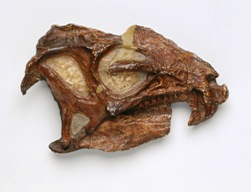
A tiny dinosaur skull with an unusual set of teeth has been identified by a team of scientists from London, Cambridge and Chicago, writes Sarah Day.
Geoscientist Online 24 October 2008
At just 45 millimetres long, the skull is one of the smallest ever discovered, and has been identified as a baby
Heterodontosaurus, one of the earliest dinosaurs known to have existed on Earth. The discovery has allowed scientists to solve one of the mysteries surrounding the species – its unusual combination of teeth.
While most reptiles have teeth that are the same size all the way along their jaws,
Heterodontosaurus has fang-like canines at the front of its jaw, and worn, molar-like grinding teeth at the back. These have been the cause of debate between scientists about what the dinosaur’s diet might have been.
So far, researchers had thought that the canine teeth were possessed only by adult males, used in fighting for territory or females. However, the discovery of the canines in a baby
Heterodontosaurus suggests the teeth may have had other functions.
The team, led by Dr Richard Butler, a palaeontologist at the Natural History Museum, London, publish their research in the latest issue of the
Journal of Vertebrate Palaeontology.